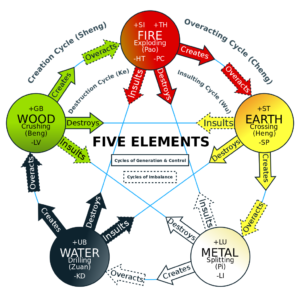Part 3: Five Element Theory
Following the Yin and Yang theory, in the 3rd century the Five Element theory was introduced which helped to understand the body as an interlinking system, where body functions are controlled through the actions of stimulation and inhibition. As with other Chinese philosophies this system is also based on observations made of the natural world. The Five Element theory is an abstract symbolization of empirical observations which reflect in medicine the various functions of the body’s organs and tissue. The theory constitutes the five phases of, wood, fire, earth, metal and water, considered to be the five indispensible materials that help to sustain life, as well as five important elemental states. 
In the book, A Collection of Ancient Works the interdependencies of the five elements is described as; “Food relies on water and fire. Production relies on metal and wood. Earth gives birth to everything. They are used by the people”. Each of the five elements are further related to categories such as the season, a direction, climate, stage of growth and development, organ, body tissue, emotion, taste, colour, sound and many other.
|
Elements |
Internal organs | Hollow organs | Sensory organs | Body layer | Emotion |
Taste |
|
Wood |
Liver | Gall bladder | Eye | Muscle | Anger | Sour |
| Fire | Heart | Small intestine | Tongue | Blood vessels | Joy | Bitter |
| Earth | Spleen | Stomach | Mouth | Connective tissue “flesh” | Anxiety | Sweet |
| Metal | Lung | Large intestine | Nose | Skin | Sadness | Spicy |
| Water | Kidney | Urinary bladder | Ear | Bone, joints | Fear |
Salty |
Based on the role and function particular body organs, the type of emotion and taste were generally representative of a particular element and thus helped to explain the nature of the organs and the relationship they had with other organs.
Primarily the Five Element Theory reminds us of how (in nature) things are connected and how our bodies relate to our environment but also defines the nature of each relationship. The two basic fundamental relationships which keep the balance of nature without which there would be instability and disturbance are;
- Generation: Generation pertains to creation, growth or production, while control is a limiting force to ensure that they do not occur too quickly or slowly, or too strongly or weakly. For example the generation of fire is dependent upon wood, or the growth of wood is dependent on water.
- Control: When in a dynamic state of equilibrium all the elements will exist in harmony but if we take our previous example when fire burns uncontrolled then it will consume all the wood, with no time left to replenish it. Similar relationships are reflected in the case of a mother and her child, where the mother gives birth and nurtures the child to grow, or in the body the relationship between the heart and spleen, where the heart generates the spleen.
All of these acts of balancing are in a state of constant flux, changing according to the need. They are necessary not just on a cosmic scale but also at the individual level.
Always remember that limitations in this theory have been acknowledged in the fact that not all of the inter-relationships between organs can be explained through this theory. However, combined with the Yin and Yang theory it served to guide Chinese medicine to develop a systematic process of clinical diagnosis and treatment.
In Part 4 we will discuss, Chinese Medicine Diagnosis: A Balancing Act.
Part 1: How Does Acupuncture Work?
Part 2: Qi: Vital Energy, Life Force
